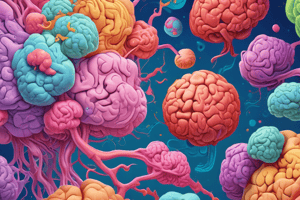Podcast
Questions and Answers
What is a teratogen?
What is a teratogen?
- A genetic anomaly present at birth
- An external factor negatively impacting development (correct)
- A congenital abnormality
- A psychological condition affecting the mother
Which of the following factors are linked to increased risks during pregnancy?
Which of the following factors are linked to increased risks during pregnancy?
- Nutrition of the mother
- Parental age
- Emotional state of the mother
- All of the above (correct)
At what maternal age is pregnancy generally considered to be the healthiest?
At what maternal age is pregnancy generally considered to be the healthiest?
- Between 20 and 35 years (correct)
- Over 35 years
- Over 40 years
- Under 20 years
What percentage of congenital abnormalities have unknown causes?
What percentage of congenital abnormalities have unknown causes?
What is the recommended sleeping pattern for neonates?
What is the recommended sleeping pattern for neonates?
Which of the following nutritional issues can lead to risks during pregnancy?
Which of the following nutritional issues can lead to risks during pregnancy?
Which feeding pattern is typical for neonates?
Which feeding pattern is typical for neonates?
How much of an increase in IQ could result from eliminating malnutrition, according to South African Health Systems Trust?
How much of an increase in IQ could result from eliminating malnutrition, according to South African Health Systems Trust?
Flashcards
Teratogen
Teratogen
External factors that negatively impact the development of a fetus.
Prenatal Influences
Prenatal Influences
Factors affecting the developing baby. It includes external factors and time of exposure, which can have negative or positive effects.
Maternal Age (Pregnancy)
Maternal Age (Pregnancy)
A parent's age during pregnancy significantly impacts the birth process and potential health of the baby (especially first-time mothers.)
Maternal Nutrition
Maternal Nutrition
The mother's diet is crucial during pregnancy. Adequate nutrition is paramount as the fetus is completely dependent on the mother for nutrients.
Signup and view all the flashcards
Malnutrition
Malnutrition
Lack of proper nutrition, either from insufficient food intake or an imbalanced diet (too little protein and vitamins).
Signup and view all the flashcards
Fetal Development
Fetal Development
The pregnancy and process of a baby developing in the womb
Signup and view all the flashcards
Neonatal Sleep
Neonatal Sleep
Newborns sleep extensively, mostly around 16-18 hours.
Signup and view all the flashcards
Neonatal Feeding
Neonatal Feeding
Newborns feed frequently, typically 8-14 times daily, and the intervals are usually between 1.5 and 5 hours.
Signup and view all the flashcards
Neonatal Learning
Neonatal Learning
Newborns learn through classical and operant conditioning, and can also imitate facial expressions from the start of their birth.
Signup and view all the flashcardsStudy Notes
Prenatal Influences
- 50% of congenital abnormalities have unknown causes.
- Teratogens are external factors negatively impacting prenatal development.
- Teratogen impact depends on: exposure timing, genetic vulnerability, severity, and specific teratogen.
- Damage may not be apparent at birth.
Environmental Factors Affecting Development
- Parental Age:
- 20-35 is ideal.
- Teen mothers (especially under 15) and mothers over 35 have increased risks.
- Older mothers (over 35) require good physical, nutritional, and psychological health.
- Paternal age also significant (generally, under 40 is healthier).
- Maternal Nutrition:
- Essential due to child's complete dependency.
- Malnutrition (inadequate or imbalanced diet) risks: stillbirth, low birth weight, premature birth, deformities, delayed growth, and death in first year.
- Elimination of malnutrition could boost population IQ by 10-15 points (South African Health Systems Trust).
- Overnutrition can also be a risk factor.
- Radiation, Infections, Medications, and Maternal Emotional State: These factors can all negatively impact prenatal development.
Neonatal Development
- Sleep: Neonates sleep 16-18 hours daily, with roughly 50% in REM sleep (compared to about 20% in adults).
- Feeding: Infants feed 8-14 times daily, with intervals of 1.5-5 hours.
- Learning:
- Rapid learning through classical and operant conditioning.
- Imitation of facial expressions (e.g., smiling, frowning) observed within 36 hours after birth.
- Temperament: Some differences are noticeable even before birth.
Infancy (0-2 Years)
- Development Areas: Physical, cognitive, personality, and social.
- Physical Development:
- Head growth slower than body.
- Weight doubles every 4-5 months in the first year, slowing in the second.
- Average height around 72 cm.
- Fontanels close.
- Teeth erupt between 6-8 months.
Studying That Suits You
Use AI to generate personalized quizzes and flashcards to suit your learning preferences.



